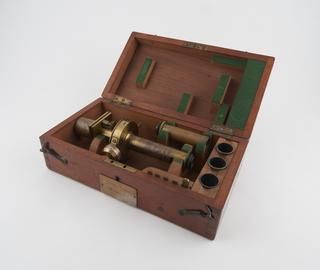
Refracting telescope of 5.9-inch aperture, mounted on English type equatorial mounting with off-set lead counterweight
1829










Refracting telescope with 5.9-inch aperture lens by Charles Tully, brass tube and English type equatorial mounting by George Dollond and clockwork drive. Made for Captain W.H.Smyth in 1828, who observed from Bedford and gave the telescope to Dr John Lee of Hartwell House near Stone, Aylesbury. Sold by Lee's executors to Royal Observatory, Greenwich for use in 1874 transit of Venus. Used at the Hong Kong Observatory from 1888 until 1914 when it was returned to Greenwich.
Admiral Smyth used this telescope to make his observations for his book, 'A Cycle of Celestial Objects' published in 1844 which was famous throughtout the 19th century. The book was the first guide to the night sky written for a non-specialist and has been much copied since. The instrument incorporates the earliest known clock drive on an English telescope.
Captain William Smyth used this telescope to survey the sky for his book, 'A Cycle of Celestial Objects', that was first published in 1844. The first guidebook of the heavens written for the amateur observer, it was an instant success. The refracting telescope with a 5.9-inch lens was installed in1829 at Smyth's observatory at Bedford. Later, Smyth sold the telescope to his good friend Dr Lee who had an observatory at Hartwell House residence near Aylesbury. It was then sold to the British government who sent it on its1874 transit of Venus expedition to Egypt. The Lee Telescope then went to the Hong Kong Observatory where it stayed until 1918 before being finally donated to the Science Museum in 1929.

1829

1829
1822-1824

1830
1830

1870-1874
1829









